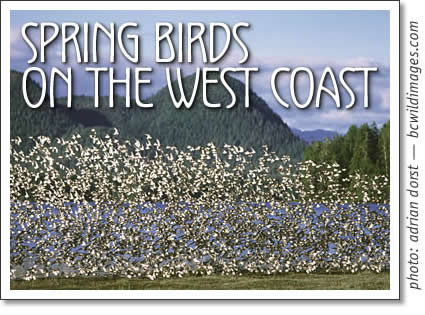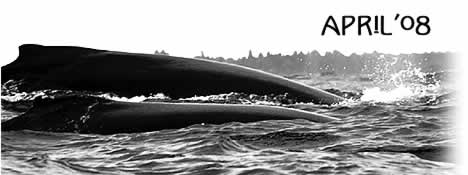
Bird watching in Tofino: Spring birds on the West Coast
by Adrian Dorst, Tofino

The west coast of Vancouver Island is outstanding for its bird life. More than 330 species of birds have been seen here and the list is still climbing. There are a number of reasons for this and they all have to do with our geographical location. We are, of course, situated on the very edge of the continent, on a shoreline that stretches from the Bering Sea to Tierra del Fuego. Countless avian migrants use this geographical feature - the continental shore - to navigate their way north and south.American Robins, geese, and shorebirds are among the more conspicuous migrants. As early as late February, American Robins begin arriving in Tofino from points south. By late March or early April, they may be seen on every lawn and open space in the area, including our beaches. At about his same time, the first Rufous Hummingbirds show up at local feeders. Their arrival is timed to coincide with the blooming of salmon berry flowers, which are by now out in numbers. Contrary to old-timer folk wisdom, they do not hitch a ride on the backs of geese but arrive here on their own steam, or more correctly, fueled by flower nectar.
Also arriving at this time, though almost unnoticed, is the rather drab, olive-green Orange-crowned Warbler. If you have keen ears you may catch its light vocal trill, for they are more easily heard than seen. It has just exchanged the dry desert scrub and cactus of Baja California, where it wintered, for the salal and salmon berry bushes of the bc coast.
In early April, we also begin to see skeins (I prefer gaggles) of geese passing overhead - Canadas, Cacklers and White-fronted - not infrequently accompanied by Northern Pintails, Mallards and Northern Shovellers. By Late April, the waves of geese become a torrent. At this time, 15,000 geese may pass over our part of the coast in a single day. Sometimes they pass directly overhead, although if the weather is favourable, they may be out to sea a mile or two and can then best be spotted from Long Beach or Chesterman. Most of these birds have wintered in the Central Valley of California and the Willamette Valley of Oregon and are, for the most part, on their way to Alaska. Some will nest in the Yukon while one subspecies will be flying as much as 3000 kilometers west of Tofino to breed in the Aleutian Islands.
While the migration of geese is conspicuous, the flight of many other birds takes place largely unseen, because many birds travel by night. Periodically, however, we get a glimpse into just how big those numbers are when a sudden storm or low overcast forces the birds down. Bird-watchers refer to these events as "fallout." Such a feathered inundation occurred a few years ago when a south-easterly storm suddenly moved in overnight, knocking Golden-crowned Sparrows out of the sky in large numbers. In the drizzly morning that followed, there were birds everywhere you looked - in the village green, along city streets and on lawns and gardens. At the Long Beach Golf Course there were more than a hundred, while at the airport nearby, I counted an astounding 500 birds in a single flock. That same weather system forced hundreds of shorebirds of a dozen different species down onto the green of the Tofino Golf Course. Among them were rare Pacific Golden Plovers, Red Knots and a Solitary Sandpiper.The first migrant shorebirds usually arrive here in early April. Greater Yellowlegs can then be found in pools of water on the mudflats or along the edge of the rising tide, seeking out small fish, which they snap up with their medium long bills. Gradually, a trickle of other shorebirds arrives, such as Western Sandpipers, Short-billed Dowitchers and Dunlin, now resplendent with their reddish backs and black bellies. Dunlin, it should be noted, may be seen here all winter long, but are then dressed in their plain winter garb.
By the third week in April, Western Sandpipers will have begun arriving. In very short order their numbers will swell and by the end of the month, or shortly thereafter, their numbers peak. At this time, flocks containing 15,000 to 20,000 birds may be seen feeding on the mudflats or fleeing an aerial assault by a Peregrine Falcon.
This is no ordinary bird. The Peregrine Falcon is up to 40 centimeters tall and has a wingspan that can reach a meter wide. This bird is a marvel of aeronautical engineering, its shape and smooth feathers superbly designed to eliminate drag. Its speed in a dive has been clocked at an astounding 349 kilometers per hour. Few events in birding are more exciting than watching one in pursuit of shorebirds. When a Peregrine attacks, bedlam ensues as 40,000 wings take to the air at once and the flock swirls and turns and swoops as though guided by a single mind. Once the falcon has completed its chase, sometimes stooping repeatedly, the sandpipers will settle on the mudflats once more and resume feeding. Once they have been chased, however, they are easily spooked.
Surprisingly, the revered Peregrine Falcon, the fastest of all birds, fails in its attempts much more frequently than it succeeds. It is very difficult, apparently, for the falcon to isolate an individual in a densely-packed flock, something it needs to do if it is to be successful. There is indeed safety in numbers.
Far more successful is the Peregrine's small cousin, the Merlin, for its modus operandi is stealth. Flying directly out of the sun, or, more often, skimming just above the surface of the water, it comes seemingly out of nowhere and strikes before its prey has a chance to take wing. Like the Peregrine, it has great speed, but with added maneuverability. Even if the hapless sandpiper spots the falcon, its chances of taking flight in time and evading this winged gymnast are slim. According to my personal count, well over half of all attacks are successful.When a Peregrine is successful it can be quite a show, such as on the day I watched a Peregrine knock a Whimbrel out of the air and into the water. Before the falcon could turn around and recover this rather large shorebird, a Bald Eagle swooped in and snatched it up over the falcon's vigorous protestations - avian curses I suppose - and flew off to feed its young. Such is life and death on the Tofino mudflats.
Prime time for shorebird viewing is generally from the third week in April to mid May, though in some years they persist for another week or two. Western Sandpiper numbers usually peak at the beginning of May, as they do for the large and impressive Marbled Godwit. The beaches too are worth checking out, for Semipalmated Plovers, Dunlin, Godwits, Black-bellied Plovers and who knows what else. If you have reasonably good luck, you will see a Peregrine Falcon or a Merlin. If you are really lucky, you may see a rare Snowy Plover from south of the border, as I have on several occasions. But please, please, keep your dog on a leash during shorebird season. Enjoy the show.
Tofino photographer and local bird expert Adrian Dorst offers guided bird walks and guided nature hikes in the Meares Island rainforest. Call him at (250) 725-1243 or email adorst AT telus.net. Visit Adrian's photography websites at ww.adriandorst.com and www.bcwildimages.com.
Tofino Birdwatching Articles
- Tofino Birding: Brown Pelicans in Tofino August 2006
- Falcons of Tofino Nov. 2004
- Fall Bird Migration Oct. 2004
- Fall Bird Migration Oct. 2004
- Rare Birds in Tofino Aug. 2004
- The Windbirds are Back! May 2002
- Ospreys in Tofino Sep. 2005
- Tofino Birdwatching Oct. 2003
- Tofino Shorebird Festival 04 May 2004
- Watch Birds! June 2002
- Who gives a hoot? Tofino Birding: Owls Feb. 2005
- Winds from the South… May 2004
- The Watchers: Birders in Tofino April 2009
Tofino Time April 2008
- Tofino in April 2008
- Tofino surfing: The frontside snap
- Tofino tides: Tide table for Tofino April 2008
- Tofino concerts in April 2008
- Tofino business profile: Clayoquot Crafts
- Bird watching in Tofino: Spring birds on the West Coast
- Tofino's 11th Annual Pacific Rim Shorebird festival
- Tofino history: The Wreck of the Favorite
- Tofino Earth Day weekend
- Tofino Time: The clean little secret
- Tofino fishing in April
- April Gardening in Tofino 2008
- Tofino garden plants: Helleborus
- Tofino profile: Shirley Langer
- Tofino Shorebird festival 2008
- Tofino Horoscope for April 2008
- Events in Tofino: Entertainment & community events in April 2008
- Community Directory: Goods & Services in Tofino
tofino | tofino time | activities | accommodation | events | directory
maps | travel | food | art & artists | photos | horoscope | tides
search | magazine | issues | articles | advertising | contact us
hosted in tofino by tofino.net & studio tofino
© 2002-2014 copyright Tofino Time Magazine in Tofino Canada

